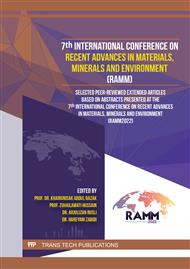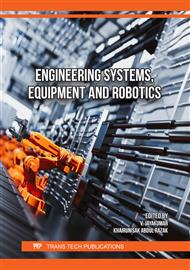[1]
MPOC, "Malaysian Palm Oil Industry – MPOC," Malaysia Palm Oil Industry, 2020.
Google Scholar
[2]
V. S. Shevade and T. V. Loboda, "Oil palm plantations in Peninsular Malaysia: Determinants and constraints on expansion," PLoS One, vol. 14, no. 2, p. e0210628, Feb. 2019.
DOI: 10.1371/journal.pone.0210628
Google Scholar
[3]
G. Su, N. W. Mohd Zulkifli, H. C. Ong, S. Ibrahim, Q. Bu, and R. Zhu, "Pyrolysis of oil palm wastes for bioenergy in Malaysia: A review," Renewable and Sustainable Energy Reviews, vol. 164, p.112554, Aug. 2022.
DOI: 10.1016/J.RSER.2022.112554
Google Scholar
[4]
M. Faizi et al., "An overview of the Oil Palm Empty Fruit Bunch (OPEFB) potential as reinforcing fibre in polymer composite for energy absorption applications," 2016.
DOI: 10.1051/matecconf/20179001064
Google Scholar
[5]
P. Kahar et al., "An integrated biorefinery strategy for the utilization of palm-oil wastes," Bioresour Technol, vol. 344, p.126266, Jan. 2022.
DOI: 10.1016/J.BIORTECH.2021.126266
Google Scholar
[6]
S. Prasertsan and P. Prasertsan, "Biomass residues from palm oil mills in Thailand: An overview on quantity and potential usage," Biomass Bioenergy, vol. 11, no. 5, p.387–395, Jan. 1996.
DOI: 10.1016/S0961-9534(96)00034-7
Google Scholar
[7]
N. Abdullah and F. Sulaim, "The Oil Palm Wastes in Malaysia," in Biomass Now - Sustainable Growth and Use, InTech, 2013.
DOI: 10.5772/55302
Google Scholar
[8]
I. Nurika, E. N. Shabrina, N. Azizah, S. Suhartini, T. D. H. Bugg, and G. C. Barker, "Application of ligninolytic bacteria to the enhancement of lignocellulose breakdown and methane production from oil palm empty fruit bunches (OPEFB)," Bioresour Technol Rep, vol. 17, p.100951, Feb. 2022.
DOI: 10.1016/J.BITEB.2022.100951
Google Scholar
[9]
J. George and S. N. Sabapathi, "Cellulose nanocrystals: Synthesis, functional properties, and applications," Nanotechnol Sci Appl, vol. 8, p.45–54, Nov. 2015.
DOI: 10.2147/NSA.S64386
Google Scholar
[10]
E. N. N. Arbaain, E. K. Bahrin, N. M. Noor, M. F. Ibrahim, N. Ramli, and S. Abd-Aziz, "Chemical-free pretreatment of unwashed oil palm empty fruit bunch by using locally isolated fungus (Schizophyllum commune ENN1) for delignification," Food and Bioproducts Processing, vol. 118, p.207–216, Nov. 2019.
DOI: 10.1016/J.FBP.2019.09.001
Google Scholar
[11]
S. Gea, A. H. Siregar, E. Zaidar, M. Harahap, D. P. Indrawan, and Y. A. Perangin-Angin, "Isolation and characterisation of cellulose nanofibre and lignin from oil palm empty fruit bunches," Materials, vol. 13, no. 10, May 2020.
DOI: 10.3390/ma13102290
Google Scholar
[12]
R. Marwah, N. A. Ibrahim, N. Zainuddin, W. Z. Saad, N. I. A. Razak, and B. W. Chieng, "The Effect of Fiber Bleaching Treatment on the Properties of Poly(lactic acid)/Oil Palm Empty fruit Bunch Fiber Composites," Int J Mol Sci, vol. 15, no. 8, p.14728–14742, 2014.
DOI: 10.3390/ijms150814728
Google Scholar
[13]
T. M. N. A. Mohammad, W. Yeheye, and J. N. Muhd, "Cellulose as reinforcement in nitrile butadiene rubber," Cellulose chemistry and Technology, vol. 54, no. 1, p.11–25, 2020.
Google Scholar
[14]
E. S. Abdul Rashid, W. A. Yehye, N. Muhd Julkapli, and S. B. O. A. Abdul Hamid, "Effect of Nanocellulose Loading on Tensile Properties of Nitrile Rubber," Solid State Phenomena, vol. 264, p.112–115, Sep. 2017.
DOI: 10.4028/www.scientific.net/SSP.264.112
Google Scholar
[15]
S. Phomrak, A. Nimpaiboon, B. Z. Newby, and M. Phisalaphong, "Natural Rubber Latex Foam Reinforced with Micro-," 2020.
DOI: 10.3390/polym12091959
Google Scholar
[16]
S. Daud, O. Y. H. Lik, and A. R. Azura, "The effects of nano-cellulose filler on tensile and thermal properties of natural rubber latex films," in AIP Conference Proceedings, Sep. 2020, vol. 2267.
DOI: 10.1063/5.0016167
Google Scholar
[17]
R. Blanchard, E. O. Ogunsona, S. Hojabr, R. Berry, and T. H. Mekonnen, "Synergistic Cross-linking and Reinforcing Enhancement of Rubber Latex with Cellulose Nanocrystals for Glove Applications," ACS Appl Polym Mater, vol. 2, no. 2, p.887–898, Feb. 2020.
DOI: 10.1021/acsapm.9b01117
Google Scholar
[18]
E. Abraham et al., "Physicomechanical properties of nanocomposites based on cellulose nanofibre and natural rubber latex," Cellulose, vol. 20, no. 1, p.417–427, 2013.
DOI: 10.1007/s10570-012-9830-1
Google Scholar
[19]
R. Blanchard, E. O. Ogunsona, S. Hojabr, R. Berry, and T. H. Mekonnen, "Synergistic Cross-linking and Reinforcing Enhancement of Rubber Latex with Cellulose Nanocrystals for Glove Applications," ACS Appl Polym Mater, vol. 2, no. 2, p.887–898, 2020.
DOI: 10.1021/acsapm.9b01117
Google Scholar
[20]
W. Zhang, X. Zhang, M. Liang, and C. Lu, "Mechanochemical preparation of surface-acetylated cellulose powder to enhance mechanical properties of cellulose-filler-reinforced NR vulcanizates," Compos Sci Technol, vol. 68, no. 12, p.2479–2484, 2008.
DOI: 10.1016/j.compscitech.2008.05.005
Google Scholar



